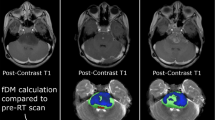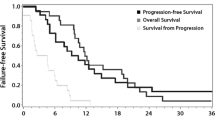Abstract
Purpose
Diffuse intrinsic pontine glioma (DIPG) remains the main cause of death in children with brain tumors. Given the inefficacy of numerous peripherally delivered agents to treat DIPG, convection enhanced delivery (CED) of therapeutic agents is a promising treatment modality. The purpose of this study was to determine which MR imaging type provides the best discrimination of intratumoral heterogeneity to guide future stereotactic implantation of CED catheters into the most cellular tumor regions.
Methods
Patients ages 18 years or younger with a diagnosis of DIPG from 2000 to 2015 were included. Radiographic heterogeneity index (HI) of the tumor was calculated by measuring the standard deviation of signal intensity of the tumor (SDTumor) normalized to the genu of the corpus callosum (SDCorpus Callosum). Four MR image types (T2-weighted, contrast-enhanced T1-weighted, FLAIR, and ADC) were analyzed at several time points both before and after radiotherapy and chemotherapy. HI values across these MR image types were compared and correlated with patient survival.
Results
MR images from 18 patients with DIPG were evaluated. The mean survival ± standard deviation was 13.8 ± 13.7 months. T2-weighted images had the highest HI (mean ± SD, 5.1 ± 2.5) followed by contrast-enhanced T1-weighted images (3.7 ± 1.5), FLAIR images (3.0 ± 1.1), and ADC maps (1.6 ± 0.4). ANOVA demonstrated that HI values were significantly higher for T2-weighted images than FLAIR (p < 0.01) and ADC (p < 0.0001). Following radiotherapy, T2-weighted and contrast-enhanced T1-weighted image HI values increased, while FLAIR and ADC HI values decreased. Univariate and multivariate analyses did not reveal a relationship between HI values and patient survival (p > 0.05).
Conclusions
For children with DIPG, T2-weighted MRI demonstrates the greatest signal intensity variance suggesting tumor heterogeneity. Within this heterogeneity, T2-weighted signal hypointensity is known to correlate with increased cellularity and thus may represent a putative target for CED catheter placement in future clinical trials.



Similar content being viewed by others
References
Poussaint TY, Vajapeyam S, Ricci KI, Panigrahy A, Kocak M, Kun LE, Boyett JM, Pollack IF, Fouladi M (2016) Apparent diffusion coefficient histogram metrics correlate with survival in diffuse intrinsic pontine glioma: a report from the pediatric brain tumor consortium. Neuro-Oncology 18(5):725–734. https://doi.org/10.1093/neuonc/nov256
Dolecek TA, Propp JM, Stroup NE, Kruchko C (2012) CBTRUS statistical report: primary brain and central nervous system tumors diagnosed in the United States in 2005-2009. Neuro-Oncology 14(Suppl 5):49
Donaldson SS, Laningham F, Fisher PG (2006) Advances toward an understanding of brainstem gliomas. J Clin Oncol: Off J Am Soc Clin Oncol 24(8):1266–1272. https://doi.org/10.1200/JCO.2005.04.6599
Hargrave D, Bartels U, Bouffet E (2006) Diffuse brainstem glioma in children: critical review of clinical trials. Lancet Oncol 7(3):241–248. https://doi.org/10.1016/S1470-2045(06)70615-5
Buczkowicz P, Hawkins C (2015) Pathology, molecular genetics, and epigenetics of diffuse intrinsic pontine glioma. Front Oncol 5:147. https://doi.org/10.3389/fonc.2015.00147
Morales La Madrid A, Hashizume R, Kieran MW (2015) Future clinical trials in DIPG: bringing epigenetics to the clinic. Front Oncol 5:148. https://doi.org/10.3389/fonc.2015.00148
Bradley KA, Pollack IF, Reid JM, Adamson PC, Ames MM, Vezina G, Blaney S, Ivy P, Zhou T, Krailo M, Reaman G, Mehta MP, Group Cs (2008) Motexafin gadolinium and involved field radiation therapy for intrinsic pontine glioma of childhood: a Children’s Oncology Group phase I study. Neuro-Oncology 10(5):752–758. https://doi.org/10.1215/15228517-2008-043
Bredlau AL, Korones DN (2014) Diffuse intrinsic pontine gliomas: treatments and controversies. Adv Cancer Res 121:235–259. https://doi.org/10.1016/B978-0-12-800249-0.00006-8
Heiss JD, Walbridge S, Asthagiri AR, Lonser RR (2010) Image-guided convection-enhanced delivery of muscimol to the primate brain. J Neurosurg 112(4):790–795. https://doi.org/10.3171/2009.7.JNS09652
Lonser RR, Walbridge S, Garmestani K, Butman JA, Walters HA, Vortmeyer AO, Morrison PF, Brechbiel MW, Oldfield EH (2002) Successful and safe perfusion of the primate brainstem: in vivo magnetic resonance imaging of macromolecular distribution during infusion. J Neurosurg 97(4):905–913. https://doi.org/10.3171/jns.2002.97.4.0905
Murad GJ, Walbridge S, Morrison PF, Szerlip N, Butman JA, Oldfield EH, Lonser RR (2007) Image-guided convection-enhanced delivery of gemcitabine to the brainstem. J Neurosurg 106(2):351–356. https://doi.org/10.3171/jns.2007.106.2.351
Anderson RC, Kennedy B, Yanes CL, Garvin J, Needle M, Canoll P, Feldstein NA, Bruce JN (2013) Convection-enhanced delivery of topotecan into diffuse intrinsic brainstem tumors in children. J Neurosurg Pediatr 11(3):289–295. https://doi.org/10.3171/2012.10.PEDS12142
Barua NU, Lowis SP, Woolley M, O'Sullivan S, Harrison R, Gill SS (2013) Robot-guided convection-enhanced delivery of carboplatin for advanced brainstem glioma. Acta Neurochir 155(8):1459–1465. https://doi.org/10.1007/s00701-013-1700-6
Chittiboina P, Heiss JD, Warren KE, Lonser RR (2014) Magnetic resonance imaging properties of convective delivery in diffuse intrinsic pontine gliomas. J Neurosurg Pediatr 13(3):276–282. https://doi.org/10.3171/2013.11.PEDS136
Lonser RR, Warren KE, Butman JA, Quezado Z, Robison RA, Walbridge S, Schiffman R, Merrill M, Walker ML, Park DM, Croteau D, Brady RO, Oldfield EH (2007) Real-time image-guided direct convective perfusion of intrinsic brainstem lesions. Technical note. J Neurosurg 107(1):190–197. https://doi.org/10.3171/JNS-07/07/0190
Kornreich L, Schwarz M, Karmazyn B, Cohen IJ, Shuper A, Michovitz S, Yaniv I, Fenig E, Horev G (2005) Role of MRI in the management of children with diffuse pontine tumors: a study of 15 patients and review of the literature. Pediatr Radiol 35(9):872–879. https://doi.org/10.1007/s00247-005-1502-y
Fischbein NJ, Prados MD, Wara W, Russo C, Edwards MS, Barkovich AJ (1996) Radiologic classification of brain stem tumors: correlation of magnetic resonance imaging appearance with clinical outcome. Pediatr Neurosurg 24(1):9–23. https://doi.org/10.1159/000121010
Liu AK, Brandon J, Foreman NK, Fenton LZ (2009) Conventional MRI at presentation does not predict clinical response to radiation therapy in children with diffuse pontine glioma. Pediatr Radiol 39(12):1317–1320. https://doi.org/10.1007/s00247-009-1368-5
Hargrave D, Chuang N, Bouffet E (2008) Conventional MRI cannot predict survival in childhood diffuse intrinsic pontine glioma. J Neuro-Oncol 86(3):313–319. https://doi.org/10.1007/s11060-007-9473-5
Clerk-Lamalice O, Reddick WE, Li X, Li Y, Edwards A, Glass JO, Patay Z (2016) MRI evaluation of non-necrotic T2-hyperintense foci in pediatric diffuse intrinsic pontine glioma. AJNR Am J Neuroradiol. https://doi.org/10.3174/ajnr.A4814
Conway AE, Reddick WE, Li Y, Yuan Y, Glass JO, Baker JN, Kun LE, Broniscer A, Patay Z (2014) “Occult” post-contrast signal enhancement in pediatric diffuse intrinsic pontine glioma is the MRI marker of angiogenesis? Neuroradiology 56(5):405–412. https://doi.org/10.1007/s00234-014-1348-9
Löbel U, Sedlacik J, Reddick WE, Kocak M, Ji Q, Broniscer A, Hillenbrand CM, Patay Z (2011) Quantitative diffusion-weighted and dynamic susceptibility-weighted contrast-enhanced perfusion MR imaging analysis of T2 hypointense lesion components in pediatric diffuse intrinsic pontine glioma. AJNR Am J Neuroradiol 32(2):315–322. https://doi.org/10.3174/ajnr.A2277
Löbel U, Sedlacik J, Sabin ND, Kocak M, Broniscer A, Hillenbrand CM, Patay Z (2010) Three-dimensional susceptibility-weighted imaging and two-dimensional T2*-weighted gradient-echo imaging of intratumoral hemorrhages in pediatric diffuse intrinsic pontine glioma. Neuroradiology 52(12):1167–1177. https://doi.org/10.1007/s00234-010-0771-9
Paugh BS, Broniscer A, Qu C, Miller CP, Zhang J, Tatevossian RG, Olson JM, Geyer RJ, Chi SN, da Silva N, Onar-Thomas A, Baker JN, Gajjar A, Ellison DW, Baker SJ (2011) Genome-wide analyses identify recurrent amplifications of receptor tyrosine kinases and cell-cycle regulatory genes in diffuse intrinsic pontine glioma. J Clin Oncol 29(30):3999–4006. https://doi.org/10.1200/JCO.2011.35.5677
Poussaint TY, Kocak M, Vajapeyam S, Packer RI, Robertson RL, Geyer R, Haas-Kogan D, Pollack IF, Vezina G, Zimmerman R, Cha S, Patay Z, Boyett JM, Kun LE (2011) MRI as a central component of clinical trials analysis in brainstem glioma: a report from the Pediatric Brain Tumor Consortium (PBTC). Neuro-Oncology 13(4):417–427. https://doi.org/10.1093/neuonc/noq200
Lober RM, Cho Y-JJ, Tang Y, Barnes PD, Edwards MS, Vogel H, Fisher PG, Monje M, Yeom KW (2014) Diffusion-weighted MRI derived apparent diffusion coefficient identifies prognostically distinct subgroups of pediatric diffuse intrinsic pontine glioma. J Neuro-Oncol 117(1):175–182. https://doi.org/10.1007/s11060-014-1375-8
Boucher Y, Salehi H, Witwer B, Harsh GR, Jain RK (1997) Interstitial fluid pressure in intracranial tumours in patients and in rodents. Br J Cancer 75(6):829–836. https://doi.org/10.1038/bjc.1997.148
Oh J, Cha S, Aiken AH, Han ET, Crane JC, Stainsby JA, Wright GA, Dillon WP, Nelson SJ (2005) Quantitative apparent diffusion coefficients and T2 relaxation times in characterizing contrast enhancing brain tumors and regions of peritumoral edema. J Magn Reson Imaging : JMRI 21(6):701–708. https://doi.org/10.1002/jmri.20335
Acknowledgements
The authors wish to thank Kristy Averette, RN, for assistance with the IRB submission.
Funding
This study was supported by the Southeastern Brain Tumor Foundation (EMT), Rory David Deutsch Foundation (OJB).
Author information
Authors and Affiliations
Contributions
Concept and design: Farber, Harward, Becher, Thompson. Acquisition of data: Farber and Harward. Analysis and interpretation of data: all authors. Drafting the article: Farber, Harward, Malinzak, Thompson. Critically revising the article: all authors. Statistical analysis: Farber, Harward, Thompson. Final manuscript approval on behalf of all authors: Thompson.
Corresponding author
Ethics declarations
Conflict of interest
The authors report no conflict of interest concerning the materials or methods used in this study or the findings specified in this paper.
Additional information
Portions of this work were presented as proceedings at the AANS Annual Scientific Meeting, American Association of Neurological Surgeons, Los Angeles, CA, USA, April 23, 2017.
Rights and permissions
About this article
Cite this article
Harward, S., Harrison Farber, S., Malinzak, M. et al. T2-weighted images are superior to other MR image types for the determination of diffuse intrinsic pontine glioma intratumoral heterogeneity. Childs Nerv Syst 34, 449–455 (2018). https://doi.org/10.1007/s00381-017-3659-8
Received:
Accepted:
Published:
Issue Date:
DOI: https://doi.org/10.1007/s00381-017-3659-8




